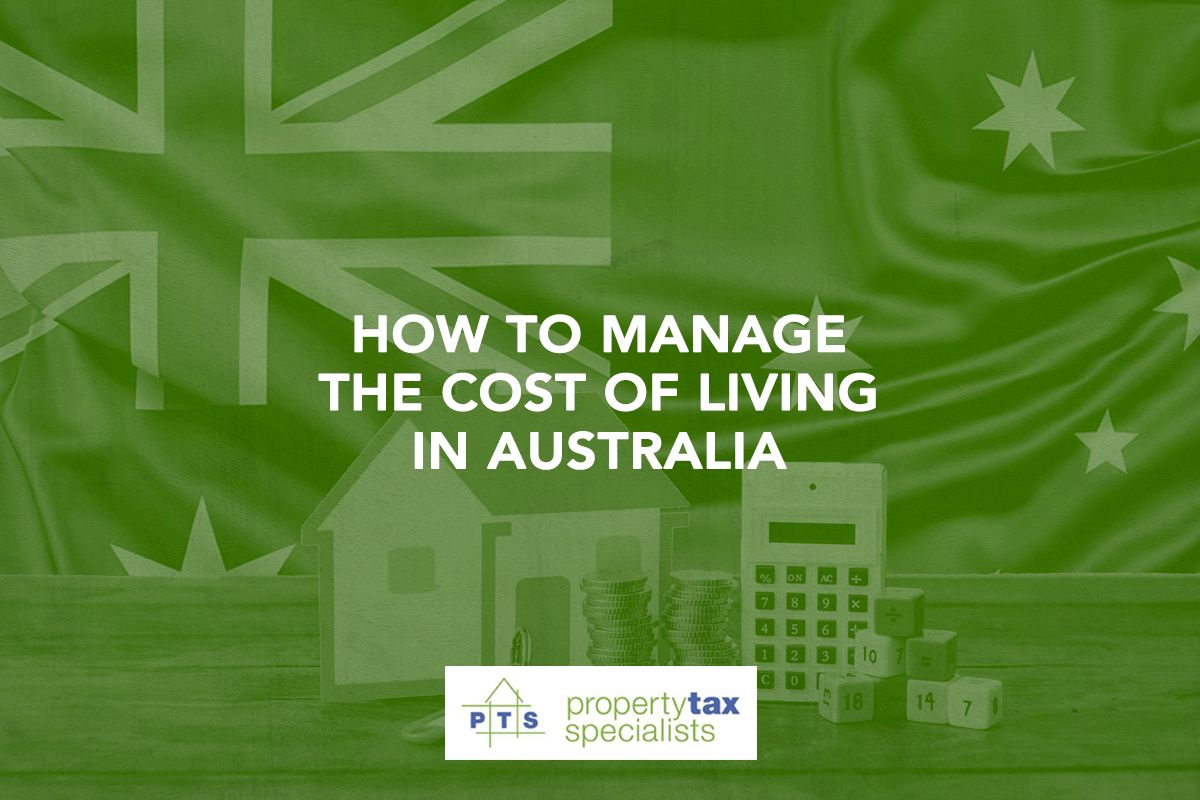How To Manage the Cost of Living in Australia
The cost of living in major cities across Australia has been steadily rising, putting immense pressure on household budgets nationwide. Soaring prices for essentials like groceries and utilities have made it increasingly challenging for families to make ends meet.
However, there’s a potential solution for homeowners and property investors – implementing smart property tax strategies.
While property taxes may seem like an unavoidable expense, leveraging the Australian tax system effectively can provide much-needed financial relief during these tough economic times. It may be possible to save thousands of dollars per year by maximising deductions, credits, and concessions, easing some of the strain caused by the cost of living crisis.
This comprehensive guide will examine the role of property taxes in the cost of living equation and outline practical strategies to help you navigate these challenging circumstances.
What is the Cost of Living Crisis in Australia?
Australia’s cost of living crisis has been driven by a perfect storm of economic factors. Inflation rates have skyrocketed, reaching multi-decade highs and putting immense pressure on household budgets.
The Consumer Price Index (CPI), which measures changes in the prices of consumer goods and services, rose by 7.8% in the 12 months to December 2022 – the highest annual increase since 1990.
This surge in inflation has been fuelled by a combination of supply chain disruptions, labour shortages, and rising interest rates. Global supply chains were severely impacted by the COVID-19 pandemic, leading to shortages and increased costs for a wide range of goods. Additionally, the war in Ukraine has exacerbated the situation, driving up global oil prices, basic expenses and essential commodities.
The impact of the cost of living crisis has been felt across all demographics, but some groups have been hit harder than others.
Young Australians, particularly those in the Gen Z and millennial generations, have struggled to keep up with the rising costs of housing, tuition fees, car costs and basic necessities. Older Australians on fixed incomes have also been significantly affected, as their purchasing power has diminished.
What is the Consumer Price Index?
The Consumer Price Index (CPI) is a key economic indicator that measures the average change in prices paid by Australian households for a basket of goods and services over time. It is calculated and published quarterly by the Australian Bureau of Statistics (ABS).
In Australia, the CPI is designed to measure inflation faced by households across the country. It tracks the cost of a fixed basket of items that represents the typical consumption patterns of Australian households. This basket includes essential expenses like food, housing, utilities, transportation, healthcare, education, and recreation.
By monitoring changes in the CPI over time, economists and policymakers can gauge the overall inflation rate in the economy. A rising CPI indicates that the cost of living is increasing, while a declining CPI suggests that the purchasing power of consumers is improving.
The CPI is particularly relevant in the context of the cost of living crisis in Australia. As prices for essential goods and services continue to rise, as reflected by the increasing CPI, households are facing greater financial strain.
The Role of Property Taxes in the Cost of Living Equation
Property taxes are a significant expense for homeowners and investors in Australia, and their impact on living costs can’t be overlooked. These taxes can vary considerably depending on the location, property value, and local council rates.
For homeowners, property taxes are often bundled with mortgage repayments, adding to the overall housing costs. As interest rates continue to rise, mortgage payments have become increasingly burdensome, further straining household budgets.
In fact, the Reserve Bank of Australia (RBA) has raised interest rates a number of times since May 2022, with the cash rate currently sitting at 4.35% (as of March 2024).
The cost of living crisis has made it crucial for homeowners and investors to maximise their property tax deductions and credits. Taxpayers can potentially save a great deal of money by understanding the intricacies of the Australian tax system and implementing smart strategies.
For property investors, property taxes can be a significant ongoing expense, particularly for those with multiple investment properties. However, the Australian tax system provides various deductions and concessions that can help offset these costs, making investment properties more financially viable.
Smart Property Tax Strategies to Ease the Burden
Getting your head around the complexities of the Australian tax system can be intimidating, but understanding and implementing the right property tax strategies can yield significant financial benefits and potentially allow you to save money.
Here are some smart approaches to consider:
Claiming Depreciation Deductions on Investment Properties
One of the most valuable deductions available to property investors is depreciation. This allows you to claim a portion of the cost of the building and its fixtures and fittings as a tax deduction over time. Investors can save thousands of dollars annually by maximising depreciation deductions and reducing taxable income.
Utilising Negative Gearing for Rental Properties
Negative gearing is a popular strategy among Australian property investors. It occurs when the costs associated with an investment property (including interest, property taxes, and maintenance) exceed the rental income generated. The resulting loss can be claimed as a deduction against other taxable income, providing valuable tax relief.
Taking Advantage of Capital Gains Tax Concessions
When it comes time to sell an investment property, capital gains tax (CGT) can significantly impact your profits. However, the Australian tax system offers concessions that can reduce your CGT liability. For instance, if you’ve owned the property for more than 12 months, you may be eligible for a 50% CGT discount on the capital gain.
Case Studies and Examples
To better illustrate the potential savings and benefits of implementing smart property tax strategies, let’s explore some real-life case studies and examples:
Case Study 1: Depreciation Deductions for an Investment Property
Sarah and Michael, a couple in their early 30s, recently purchased an investment property in Melbourne for $650,000. In their first year of ownership, they were able to claim $12,000 in depreciation deductions on the building and its fixtures. Assuming a marginal tax rate of 37%, this deduction resulted in tax savings of $4,440.
Case Study 2: Negative Gearing for a Rental Property
Jessica, a single mother in her 40s, owns a rental property in Sydney that generates $30,000 in annual rental income. However, her expenses, including interest on the mortgage, property taxes, and maintenance costs, total $38,000 for the year. This negative gearing situation allows Jessica to claim a $8,000 deduction against her other taxable income, potentially saving her thousands in tax.
Example: Capital Gains Tax Concession
Suppose you purchased an investment property in Brisbane for $400,000 and sold it five years later for $550,000, realising a capital gain of $150,000. If you’re eligible for the 50% CGT discount, your taxable capital gain would be reduced to $75,000. Assuming a marginal tax rate of 37%, this concession could save you $27,750 in tax.
These case studies and examples demonstrate the significant financial impact that smart property tax strategies can have on Australian taxpayers.
With the help of a property tax specialist, you can ensure that you’re taking full advantage of all available deductions, credits, and concessions, potentially saving you a substantial amount of money each year.
How a Specialist Can Help Identify Opportunities and Ensure Compliance
One of the primary advantages of working with Property Tax Specialists is our ability to identify opportunities that you may have overlooked. With our in-depth knowledge and experience, we can analyse your situation and recommend strategies that you may not have considered, potentially unlocking significant tax savings.
Furthermore, one of our specialist’s can help ensure that you remain compliant with all relevant tax laws and regulations. Inadvertent mistakes or oversights in tax matters can lead to costly penalties and audits, which can negate any potential savings.
Working with a professional ensures that your tax affairs are handled properly and efficiently.
Key Takeaways
- Claim depreciation deductions on investment properties to reduce taxable income.
- Utilise negative gearing to deduct rental property losses from other income.
- Take advantage of capital gains tax concessions when selling an investment property.
- Maximise deductions for home office expenses if working remotely.
- Engage a Property Tax Specialist for expert guidance and compliance.
Take the first step today by consulting Property Tax Specialists and exploring the strategies that best suit your unique circumstances. With the right approach, you can turn the cost of living crisis into an opportunity to optimise your financial situation and secure a more prosperous future.
FAQs
What is the Estimated Monthly Costs of Living in Australia?
The average living cost for a single person in Australia is estimated to be around AU$5,253 per month. For a family of four, the estimated monthly living cost is around AU$9,087.
How Much Does It Cost To Go Live in Australia?
To live comfortably in Australia, a single person would likely need around AU$60,000 – AU$70,000 per year. For a family of four, the estimated yearly average household cost is around AU$100,000 – AU$115,000.
How Much Money Do You Need To Survive in Australia?
To simply survive or cover basic living expenses in Australia, the minimum amount needed is likely lower than the average costs mentioned above. According to one source, a family of four may need approximately AU$6,840 per month to live comfortably, which would equate to around AU$82,080 annually.
It’s important to note that these are just estimates, and the actual cost of living can vary significantly based on individual circumstances, location within Australia, and lifestyle choices. Factors like housing, transportation, food, and entertainment expenses can all impact the overall cost of living.
What is the Wage Price Index?
The Wage Price Index (WPI) is a key economic indicator published quarterly by the Australian Bureau of Statistics (ABS) that measures the change in the price of labour over time.
Specifically, the WPI tracks the changes in ordinary hourly rates of pay for a fixed basket of jobs, excluding factors like bonuses, overtime payments, and changes in the quality or quantity of work performed. It aims to isolate pure price movements in wage and salary costs.
Disclaimer
Please note that every effort has been made to ensure that the information provided in this guide is accurate. You should note, however, that the information is intended as a guide only, providing an overview of general information available to property buyers and investors. This guide is not intended to be an exhaustive source of information and should not be seen to constitute legal, tax or investment advice. You should, where necessary, seek your own advice for any legal, tax or investment issues raised in your affairs.



